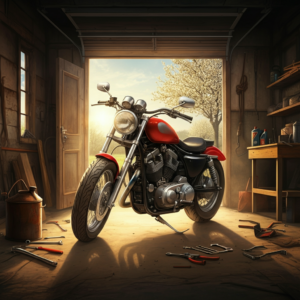
Spring is finally here—the perfect time to gear up, dust off your bike, and get back on the open road. But if your motorcycle has been sitting idle in storage through the cold months, there are a few things you should check before turning the key. Long-term storage can lead to a variety of issues, and skipping critical maintenance steps could leave you stranded or even put your safety at risk.
How Long-Term Storage Affects Your Motorcycle
Leaving your motorcycle in storage for a significant period can lead to a few common issues. Gasoline goes bad, tires lose pressure, and battery power dwindles. Moisture can sneak into parts of your bike, leading to rust and corrosion. Even something as small as leaving your bike parked in one position can negatively impact parts like tires and bearings.
Understanding these problems will prepare you to fix or prevent them. It might even save you from costly repairs or replacements. On the other hand, it could prompt you to sell your motorcycle.
Common Problems After Long-Term Storage
Even with preparation, issues might crop up when pulling your motorcycle out of storage. Here are some common challenges riders face and how to address them:
- Rust: Rust can develop on exposed metal parts. Thoroughly clean affected areas and apply anti-rust lubricant. For severe rust, you might need a professional’s help.
- Carburetor Issues:Old fuel can clog the carburetor, making it hard to start the bike. Cleaning the carburetor jets and bowls can solve this.
- Stiff Suspension: After being stationary for months, the suspension might feel stiff. Test your suspension and adjust or service it as needed.
If you encounter complex issues during your inspection process, it’s worth consulting a trusted mechanic.
What to Do Before Riding After Long-Term Storage
After you take your bike out of storage, there are a few things you need to do before you can ride it.
Inspect Your Battery
Motorcycle batteries tend to lose their charge during storage, especially if they weren’t connected to a trickle charger. Check the battery terminals for corrosion, clean them if necessary, and make sure the connections are tight. Use a voltmeter to test the charge—if it’s low, recharge it or replace it if needed.
Check and Replace Your Fluid
Fluids can degrade or evaporate during long-term storage, especially engine oil and brake fluid. Here’s what you need to check:
- Engine Oil: If your motorcycle has been sitting idle for months, change the oil and oil filter. This guarantees you have fresh lubrication for a smooth ride.
- Brake Fluid: Brake fluid absorbs moisture, which can lead to decreased braking efficiency over time. Replace it if it looks dark or cloudy.
- Coolant (for liquid-cooled bikes): Check the coolant levels and top them off as needed.
- Fuel: If you didn’t use a fuel stabilizer before storing your bike, the gasoline might have turned into a sticky gel. Drain the old fuel, clean the tank if necessary, and refill it with fresh gas.
Examine Tires
Your tires are another major component that can suffer during storage. Over time, air pressure drops, and sidewalls may crack or flatten where the weight of the bike rested.
- Check Air Pressure: Use a tire pressure gauge to ensure the PSI matches the manufacturer’s recommendations.
- Inspect for Wear and Tear: Look for cracks, bulges, or flat spots. If your tires show excessive wear, replace them to avoid an unexpected blowout on the road.
Inspect The Chain or Belt
A rusty or loose chain can snap mid-ride, leaving you in a dangerous situation. Inspect the chain for rust, clean it with a chain cleaner, and lubricate it. If your motorcycle uses a drive belt, check for cracks or signs of wear.
Tests the Brakes
Ensure your brakes are in good working condition by testing both the front and rear brakes. Squeeze the levers to confirm the brakes feel firm, not spongy. Inspect brake pads to ensure they have enough life left—you don’t want to risk riding with worn pads.
Examine Cables and Lights
Over time, cables can stiffen, fray, or accumulate moisture inside their sheaths. Check your throttle, clutch, and brake cables to ensure they move smoothly.
Don’t forget your lights—test all signals, headlights, taillights, and indicators. Replace any burned-out bulbs before hitting the road.
Clean and Polish
Your bike deserves to look as good as it rides. Dust, cobwebs, or even light rust may have built up over storage. Give your motorcycle a thorough wash and apply a coat of wax to protect the paint. Cleaning your bike will also reveal any hidden damage that needs attention.
When the Work Is Too Much, Consider Selling
If the time and effort to get your motorcycle out of storage feel overwhelming—or if fixing storage-related issues gets expensive—it might be time to consider selling your motorcycle. Whether your bike no longer fits your needs or you’re looking to upgrade, selling provides an opportunity to free up resources for other investments.
Sell Us Your Bike is the best place to sell your used motorcycle online! Just fill out the quote below and get some extra cash for the season!